

CWRU 11 holds press conference regarding vandalism lawsuit
Darcy Chew Executive Editor
Eleven activists arrested in connection to last fall’s campus vandalism incident held a press conference Saturday, Oct. 4, in which speakers gave updates on their ongoing legal proceedings and alleged that Case Western Reserve University is suppressing student expression by taking retaliatory measures against pro-Palestinian sentiments. Dubbed “CWRU 11,” the group includes six individuals who were enrolled in the university at the time of the alleged vandalism.
The university alleges that between 3:30 and 4:30 a.m. on Nov. 8, 2024, a group of activists, including six CWRU students and one Cleveland Institute of Art student, plastered posters and painted messages across campus. Phrases written included “We are complicit in genocide” and “Free Gaza” on walls and walkways around Adelbert Hall, the Binary Walkway, the Case Western Reserve University School of Law and the Jack, Joseph and Morton Mandel School of Applied Social Sciences.
Later that day, President Eric Kaler sent a campuswide email addressing the vandalism.
“A group of individuals vandalized multiple buildings, structures and artwork on our campus with paint and glued posters, some of which included what the university considers antisemitic language or symbols,” he said. “We strongly condemn the actions of these individuals and are investigating the incidents. Any individual found to have been involved in vandalizing our campus will be subject to the relevant university conduct process and criminal charges.”
Following the event, four CWRU students were arrested and held in Cuyahoga County Jail in the days after the incident. Months later, on Feb. 18, 11 individuals were officially indicted by a grand jury on the charges of vandalism, possessing criminal tools and breaking and entering. One of the accused was additionally indicted with “telecommunications harassment” for allegedly repeatedly calling an associate dean.
In a press release for the case, the Cuyahoga County Prosecutor
Michael C. O’Malley reiterated the importance of peaceful protest, but stated that individuals must be held responsible for criminal acts.
“Peaceful protests are a cornerstone of our democracy,” O’Malley said. “When demonstrators cross over the line and commit criminal acts, it is our responsibility to hold those individuals responsible.”
Over the past few months the indicted activists attended pre-trial hearings, with ten of the 11 entering a pre-trial diversion program. The Observer was unable to independently confirm that all 11 were deemed eligible for acceptance into the diversion program.
During Saturday’s press conference, the group alleged the terms of their pre-trial diversion. They stated that they were required “to pay back $400,000 collectively within the next year in order to drop all potential charges.” The university alleges that $400,000 is the amount of damages caused by the vandalism, which the activists stated they believe is inflated.
They also claimed the program requires “regular drug tests,” “[having] to report back to the university” and “[asking] permission to leave the county.” It was also stated
that many of the individuals who were students at the time of the arrest are still undergoing student conduct proceedings with the university, with one student having already been expelled.
One of the indicted activists, Benjamin Mullin-Vanneste, a fourth year at the time of his arrest, commented on the university’s actions.
“Even though the university will be reimbursed for these damages, they still seek permanent termination of our undergraduate pathway at Case, so there seems to be particular animus towards us,” MullinVanneste said. “It doesn’t seem to just be about policy or accountability. This is about making an example of us to stifle any dissent and about silencing the movement for Palestine.”
During the press conference, Mullin-Vanneste also spoke about his own experiences with the university after his alleged involvement in the incident.
“I was arrested in January, a night before I was supposed to begin the final semester of my undergraduate career,” he said. “I was offered my diploma by the university in exchange for full cooperation, meaning that if I reported to them
the identity of individuals that they think were involved, then I would receive my diploma from Case Western Reserve University. When I rejected this, they shut down negotiations completely.”
Another indicted activist and CWRU student at the time of the arrest, Raïssa Rih-reh, criticized the university’s approach to student protest.
“I stand before you as someone who has experienced imprisonment and long, drawn out legal proceedings intentionally designed to intimidate, confuse and diminish hope,” Rih-reh said. “Universities, like Case Western Reserve University, should be crucibles of critical thought and training grounds for changemakers. Yet they have far strayed from that mission.”
Due to legal circumstances, the 11 individuals were unable to provide further comments to The Observer. The university also declined to provide comment, stating that they don’t “comment on ongoing legal proceedings.”
Saturday’s press conference echoes nationwide concerns about the trend of universities taking action against non-violent protests following the pro-Palestinian movement.
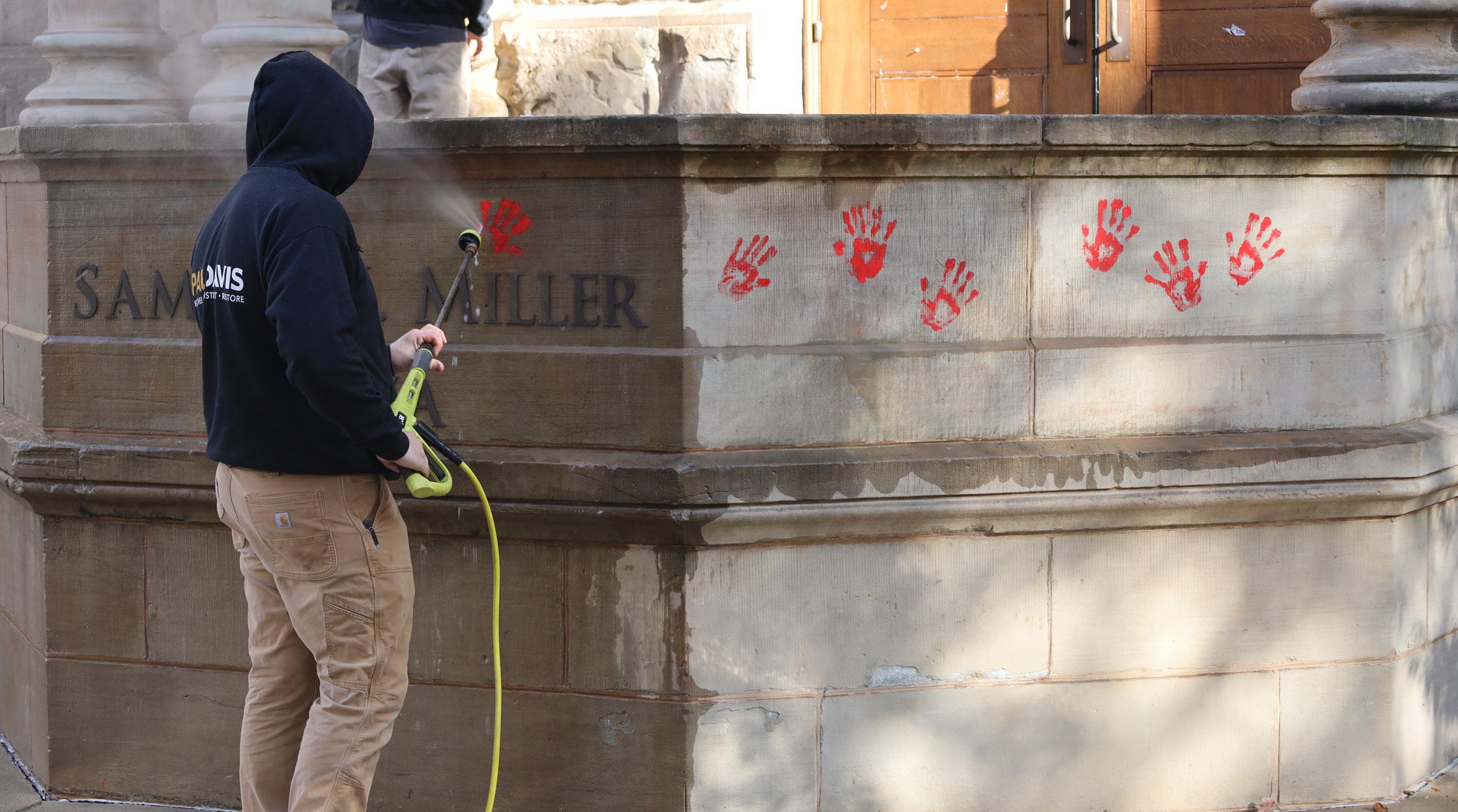
Darcy
Chew/The Observer
President Trump links acetaminophen to autism
Sabrina
During a White House press conference on Sept. 22, U.S. President Donald Trump advised pregnant women to avoid taking acetaminophen, the active ingredient in Tylenol, unless in extreme cases. He cited concerns that the drug increases the risk of autism.
“Don’t take Tylenol,” Trump said. “Don’t take it. Fight like hell not to take it.”
The president started by describ-
ing how the Food and Drug Administration would be informing physicians of the drug’s links to autism. He announced that because of these alleged risks, the FDA would soon update acetaminophen labeling to discourage pregnant women from taking Tylenol for fevers.
Many doctors and researchers, including those at Case Western Reserve University, have expressed concern about this claim and argue that there is not enough conclusive evidence to connect the two.
Kimberly McBennett, an associate professor in the Department of Medicine at Case Western Reserve University and interim chief health officer, noted the position of the
drug as one of the only pain-relievers open to pregnant women.
“It’s important to note that acetaminophen is the only over-thecounter drug approved for use to treat fevers during pregnancy, and high fevers in pregnant women can pose a risk to their children,” McBennett said. “Additionally, ibuprofen and aspirin have well-documented adverse impacts on the fetus and therefore cannot be used to treat fever during pregnancy.”
The American College of Obstetrics and Gynecology (ACOG) issued a statement in September 2025 reaffirming acetaminophen as the analgesic and antipyretic of choice for pregnant women. Their statement
includes the advising that “overstating theoretical drug risks can lead to undertreatment, which is not without its own health risks.”
These conflicting arguments between White House claims and physician recommendations can be confusing to Americans, highlighting the need for clear guidance for women struggling with health problems.
“I think it enforces the standard that women should need to suffer, that suffering is part of being a woman,” third-year biochemistry student Lucy Candeub said. “There’s a lot of pain being dismissed and that obviously affects pregnant women because then their voices aren’t heard.”
The 11 activists indicted for the November 2024 vandalism incident are still undergoing legal cases and university proceedings, almost a year later.
Tyler Sun Photo Editor
Feldberg News Editor
News-in-Brief
CAMPUS
Homecoming weekend offers food trucks, farm fun and more
This Saturday, in conjunction with Parent’s weekend, Case Western Reserve University will be hosting an array of events to treat the students, alumni, faculty and families that will be gathering for Homecoming. First, the Homecoming Tailgate will feature food trucks, interactive tabling and performances down East 115th Street from 2:00 to 4:00 p.m. At half-time during the football game, this year’s senior class Homecoming Royalty, selected by the University Spirit Committee, will be announced.
And from noon to 5 p.m., the University Farm’s Farm Harvest Festival will be offering live entertainment, a field maze, a pumpkin trebuchet, hay rides and more farm-filled fun off campus. Additionally, PERIOD will be holding its annual period fair in Thwing Atrium from 12:00 p.m. to 4 p.m. It will host CWRU and Cleveland organizations, offering free food as well as games through which students can win prizes including self-care kits, period product packs and sex toys.
COMMUNITY
Lakewood City Council rules in favor of Gender Freedom Policy
In Lakewood, Ohio, Lakewood City Council ruled 7-0 in favor of the Gender Freedom Policy. The legislation was enacted in response to concerns about the safety of transgender people at state and national levels. It focuses on retracting anti-trans legislation, as well as protecting drag performers from discrimination. The policy cited two executive orders
from the Trump Administration in late Jan., including one that declared that the U.S. government would only recognize two genders (male and female), defining sex by biological classifications, and another attempting to prevent funding for gender- affirming medical treatments for youth under the age of 19 and refuting relevant literature.
NATIONAL
Colonel Daren K. Margolin is appointed as head of immigration courts
On Oct. 7, President Donald Trump appointed retired Marine Corps Colonel Daren K. Margolin as the new head of immigration courts. Margolin served as a military lawyer in the Marine Corps, then after his retirement, the Trump Administration appointed him to be an assistant chief immigration judge from
June 2020 to 2024. Margolin will head the Executive Office for Immigration Review in the Justice Department and will oversee the entire U.S. immigration court system, including the other newly-appointed immigration judges. As head, he will review asylum requests for migrants and issue deportation orders.
INTERNATIONAL
Nobel Prizes awarded to researchers from around the world
This week, the Nobel Prizes in Physics, Physiology or Medicine, and Chemistry were awarded to people across the globe for excellence in these areas. First, on Monday, three researchers, two American and one Japanese— Mary E. Brunkow, Fred Ramsdell and Dr. Shimon Sakaguchi—won the prize for their findings on peripheral immune intolerance. According to the New York Times, the prize committee deemed their discoveries “fundamental to understanding how the body’s immune system functions.” On Tuesday, the committee announced that three Americans—John Clarke, Michael H.
Devoret and John M. Martinis—won the prize for Physics for “prov[ing] the existence of two quantum phenomena on a system visible to the human eye.” Lastly, Susumu Kitagawa, Richard Robson and Omar M. Yaghi—researchers from Japan, Australia and the United States respectively—won the prize in Chemistry for developing molecular building blocks with cavities big enough for gases and other chemicals to stream through them. The discoveries, according to the committee, open the door for the development of materials that separate toxic chemicals from wastewater or gather water molecules in a desert.
CWRU researchers make a discovery that could influence HIV treatment
Noah Paniagua Staff Writer
Researchers at Case Western Reserve University say they have uncovered a critical piece of the HIV puzzle, revealing how the virus pushes infected immune cells into a dormant state to survive undetected. The discovery, announced last week, could open new avenues for treatment by identifying the cellular programs that make this “hiding place” possible.
The research focuses on CD4+ T cells, sometimes called “helper” cells, which normally coordinate immune defenses. In people with HIV, the virus embeds itself into these cells and silences their activity. Once dormant, the cells neither fight infection nor reveal the virus inside them. This quiet state, known as latency, creates what scientists call the latent reservoir. Even when antiretroviral therapy suppresses HIV in the bloodstream, the hidden virus can reignite infection if treatment is interrupted.
For decades, the reservoir has been considered the single greatest barrier to a cure.
“We’ve shown that HIV actually orchestrates its own survival by reprogramming host cells to create the perfect hiding place,” said Saba Valadkhan, associate professor of molecular biology and microbiology at the Case Western Reserve
School of Medicine.
Jonathan Karn, professor and chair of the molecular biology and microbiology department, said the work gives scientists “specific targets to attack” in the ongoing search for therapies that go beyond lifelong suppression.
The discovery places CWRU at the center of a global challenge that has spanned more than four decades. HIV was first identified in the early 1980s, and while antiretroviral therapy has turned what was once a fatal diagnosis into a manageable chronic condition, the virus has resisted every attempt at eradication. More than 39 million people worldwide are currently living with HIV, according to UNAIDS, and about 1.3 million people were newly infected in 2024.
While the burden of HIV is worldwide, its effects are also felt close to home in Northeast Ohio. Cuyahoga County continues to report one of the highest numbers of HIV diagnoses in Ohio, with hundreds of residents living with the virus. Cleveland joined the FastTrack Cities initiative in 2023, pledging to meet international targets to reduce new infections and improve care by 2030. For public health leaders, discoveries like this one are not only scientific milestones but also practical steps toward meeting those goals.
However, researchers emphasize that translating discoveries
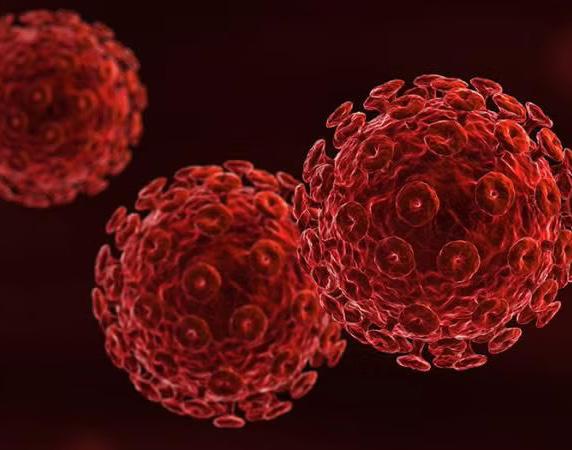
Researchers at CWRU may help relieve a decades-long burden that HIV has caused on patients and their families. Courtesy of Case Western Reserve University
into therapies will take years of additional study. Karn noted that the findings provide specific targets, but developing drugs that safely disrupt HIV’s control over host cells remains a long-term challenge. Still, the breakthrough is being met with optimism among experts. It suggests that HIV’s dormancy is not simply a matter of chance, but
a coordinated strategy by the virus. Knowing that, scientists can begin to design interventions that target the specific cellular pathways HIV manipulates. As Karn and his colleagues continue their work, the hope is that what begins as a discovery in a university lab can someday lead to treatments that dismantle HIV’s most elusive defense.
Alyssa Wang News Editor
Sabrina Feldberg News Editor
The US Government has shut down
Olivia Wen Staff Writer
On Wednesday, Oct. 1, the U.S. government shut down due to partisan budget conflicts in Congress. One of the biggest reasons Democrats have contested this year’s budget is due to differing stances on healthcare coverage. Democrats want an extension of enhanced Affordable Care Act subsidies that are
set to expire at the end of the year. The previous government shutdown took place in 2018 during President Donald Trump’s first term and lasted 35 days.
Every fiscal year begins on Oct. 1. By that date, Congress needs to allocate funding for the government and its operations for the new year. When Congress fails to pass a spending proposal, the government shuts down until lawmakers agree to pass the funding bill—in techni-

Following a failure by Congress to resolve budget disputes, the U.S. government shut down on Oct. 1. Courtesy of Stiven David Licon Contreras via Wikimedia Commons
cal terms, no funding is authorized for use until Congress agrees on a plan.
“Under normal circumstances, a long shutdown also would discourage and drive out some federal workers,” said Joseph White, a Case Western Reserve University professor in the department of political science.
During a shutdown, some federal workers deemed “non-essential,” such as tour guides of federal buildings and workers in the U.S. Environmental Protection Agency get furloughed. On the other hand, many in the Armed Forces, law enforcement and air traffic controllers work through the shutdown. Regardless if they work or not, federal workers do not get paid until the funding disagreements are resolved, placing federal workers under financial strain.
Discouraged essential workers were what helped end the shutdown in 2018. After 35 days without pay, at least 10 air traffic controllers stayed home in protest, causing delays and shutting down travel at major airports across the country and pressuring the shutdown to end.
But the White House may try to deny the automatic back pay furloughed workers are supposed to receive, according to a report from The New York Times. After the 2018 shutdown, Congress passed a law guaranteeing back pay for federal workers who bear the financial burden of funding lapses. However,
in a draft memo shared by a White House official on Sept. 30, the administration indicated “only the workers who are deemed essential may be automatically entitled to pay once the stalemate ends” and “non-essential” workers would have to wait for Congress to explicitly approve funding for their pay. No official decision has been announced and it remains unclear which employees will ultimately receive back pay until the shutdown concludes.
As for government services, programs that provide ongoing benefits like Medicare, Medicaid and Social Security will not go under. In contrast, services like specific national parks, most civil court cases and others will be shut down. The general rule of thumb is if it’s not considered critical, it will either be slowed or delayed for the time being.
“What an administration defines as ‘critical’ services is up to that administration, and clearly, this one at least wants to slow some ‘non-critical’ ones,” said White. “It may want to create problems in hopes of blaming Democrats for those problems. If the shutdown prolongs, these ‘non-essential’ or ‘non-critical’ services will obviously create problems for the public.”
Only time can tell when the shutdown will end. As of Wednesday, Oct. 8, the budget vote failed 54 to 45, with no new Democrats voting to advance the bill. To pass, six additional votes are needed to reach the required 60.
Cuyahoga County bans conversion therapy
Afshan Ara Staff Writer
Cuyahoga County recently became the first and only county in Ohio to ban conversion therapy. While state legislation remains stalled, this will impact the county in which 14% of adolescents identify as LGBTQ+. Across the state, 14 municipalities including Toledo, Columbus and Cincinnati have banned the practice. Although the area of Cleveland, Lakewood and Cleveland Heights already has local bans in place, this ordinance expands protection to the rest of the residents in Cuyahoga County. The county council members, including 10 Democrats and one Republican, voted unanimously to ban conversion therapy practices, a measure led by the council’s first openly gay member, Robert Schleper Jr. of District 6.
The ban would enforce that individuals who practice conversion therapy on minors would face the possibility of losing their license to practice medicine and fines up to $3,500. According to WebMD, conversion therapy is defined as “any emotional or physical therapy used to ‘cure’ a person’s attraction to the same sex or their gender identity and expression.” Often the process involves aversion conditioning through using chemically induced nausea, electric shocks and food deprivation. Medical professionals and mental health experts have denounced its use and ineffectiveness as well as its potential to cause a variety of mental health issues, substance use, homelessness and even suicidal ideation. The ban cites an extensive study conducted by the Williams Institute of the University of California, Los Angeles’s School of Law in 2019 on
the effects of the process. The institute has reported that several hundred thousands of Americans have been exposed to conversion therapy with nearly half being exposed during adolescence.
Schleper worked closely with the activists who brought his attention to the problem in the first place.
“When a small group of concerned citizens decide that they would like to create change, they can do so,” Shleper said in an interview with Singal Cleveland.
Brandon West, one of the activists driving the movement, started with his efforts in the city of Lorain. After researching other cities in Ohio that have banned conversion therapy, he developed a version that would work for Lorain. Now, he has set his sights on doing the same for Summit County.
To enforce the ban, the Human Rights Commission has been tasked with overseeing complaints following the same procedures used for discrimination complaints. If a Cuyahoga resident believes they have been subjected to conversion therapy practices, they can submit a formal complaint to the organization. The violation must have occurred “within three years prior to the complaint.”
Schleper also reminds that those who do file a complaint will have their identity protected under Family Education Rights and Privacy Act, known as FERPA. He also establishes that banning conversion therapy is a non-partisan issue, which may be part of the success in initiating it.
“In my opinion, this is about making sure we’re taking care of people [and] that a broadly discredited practice is no longer able to happen in our community,” Schleper said.
He believes the passing of the ban is a pivotal moment for the county
that makes it “a place for everyone.”
The unanimous support shows a moment of shared unity among council members and sends a collective message. Proponents for this ban would like to see a statewide protection, but efforts have been stuck in Ohio’s Republican dominant legislature. The county council’s lone Republican member, Michael Gallagher, recognized the struggle, researched the topic and realized that conversion therapy was not in the best interest for the residents he represents.
“This isn’t really a tough decision,” Gallagher said in an article by Cleveland News. “We really need to protect people, regardless of what
our thoughts or political beliefs might be.”
This conversation is being discussed at a national level as well. As of Oct. 7, the U.S. Supreme Court is reviewing the challenge against Colorado’s ban on conversion therapy for minors in the Chiles v. Salazar case. Kaley Chiles, a religious counselor in Colorado, argued that it infringes upon her First Amendment rights to free speech and religious expression. Ruling against Colorado could have similar implications across the country; protections against conversion therapy in areas like Cuyahoga County, where the ban was just implemented, could face similar conflicts.
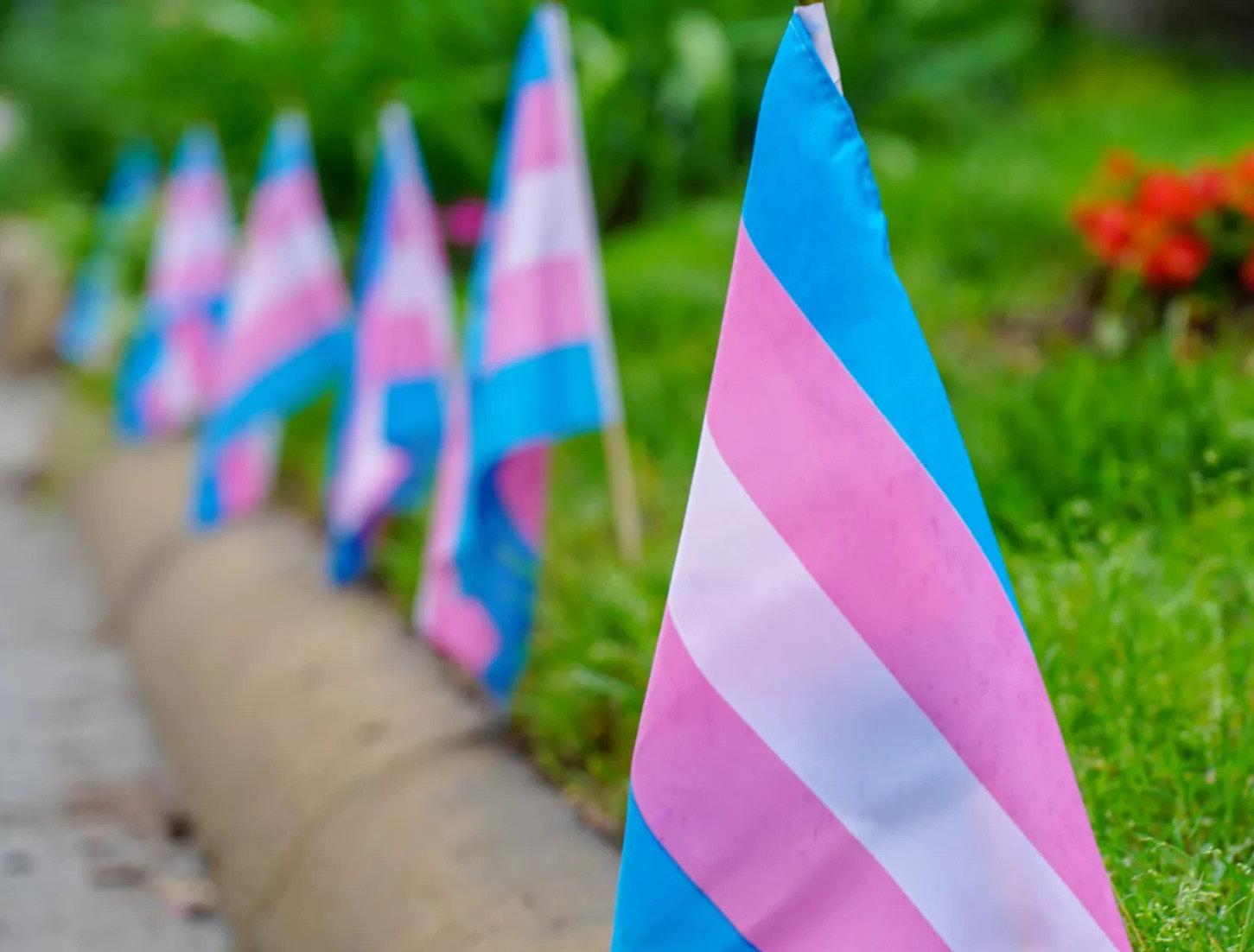
Cuyahoga County became the first county in Ohio to ban conversion therapy in September, marking significant progress for the LGBTQ+ community in the Greater Cleveland area.
Courtesy of Ted Eytan via Flickr

Taylor Swift’s “The Life of a Showgirl”—A Case Study on the Glitter Pen
Riya Kulkarni Copy Editor
After a long wait from the announcement on Aug. 12, Taylor Swift’s 12th studio album “The Life of a Showgirl” has been released. The 41 minute album contains 12 songs, with one single “The Fate of Ophelia” which has its own music video released.
Swift wrote this album during the European leg of the Eras tour, aiming to create a record that was short and sweet, a “perfect album” where it would be incomplete if any song were taken out. She comments on the relevance the album still has in her life today, still immersed in the era she was in when she wrote it. And with a new era, listeners undergo a conflict, questioning if it is indeed a good change which has taken place. This is not uncommon, these changes in tone and genre may result in an initial dislike from listeners. The transition to this era was the same.
From the beat drop of the first song, “The Fate of Ophelia,” it’s clear that this album was not written with the
same melancholy fountain pen which wrote “The Tortured Poets Department,” Swift’s 11th studio album with a focus on deep, meaningful lyrics, and a slower, calmer musical quality. “The Life of a Showgirl” may even be considered a “glitter pen album,” with catchy beats that make one want to get up and start dancing. And many have begun to dance. The music video of “The Fate of Ophelia” features a dance sequence during the chorus, which many have recreated on Instagram. Swift herself also promoted the trend, calling it “‘The Fate of Ophelia’ Challenge.”
However, it is with the retirement of the fountain pen and the re-introduction of the glitter pen that listeners question whether beyond the catchy music the lyrics were lacking. For example, “Eldest Daughter,” the fifth track in the album and—in typical Taylor style—the most emotionally vulnerable, was highly anticipated. The song touched on what it was like to love as an eldest daughter, to “[dress] up as wolves” being the “first lamb to the slaughter,” acting fierce when all you want to do is be taken care of. At the same time, this was as deep as the
song went on these specific themes. The song was touching and musically impressive, yet it was superficial and not lyrically strong.
However, many songs were more serious, or at the very least more meaningful. In “Father Figure,” Swift touches on the topic of loyalty and betrayal, where the betrayer “pulled the wrong trigger” but she “protect[ed] the family.” In “Actually Romantic,” she addresses the feeling of “…realizing that someone else has kind of had a onesided, adversarial relationship with you that you didn’t know about." Swift mocks those who hate on her, claiming that the haters are more interested in her than her lovers, and taking that as flattery. “Ruin the Friendship” took an even sadder turn as she mourned the loss of an old high school crush, wondering what would happen if she had confessed.
Many songs were just upbeat and catchy, capturing what it is like to be in love. “Opalite” and “Wi$h Li$t” were like this. In the latter song, Swift remarks that being in love got her “drеaming 'bout a driveway with a basketball hoop.” In “Honey,” she com-
ments on her insecurities, saying that love redefined all of the condescending or mean names she had been called in the past.
There isn’t anything inherently wrong about a glitter pen album, just because the lyrics are not deep enough. Reflected in many other Eras, we see pop hits that sound great, even if the lyrics are just fun but not necessarily deep. Take, for example, “22” or “Welcome to New York” from the “Red” and “1989” albums respectfully. Both of these songs are simply fun to listen to and dance to, upbeat songs that we sit and enjoy without need to overanalyze.
“The Life of a Showgirl” is the epitome of an upbeat, happy album. It is fun to listen to, even on the tenth replay. In these 12 songs, Swift brings a catchy tracklist, with every song having the potential to “stick” in a listener’s brain. Transitions throughout each song are never jarring, and each bridge is stronger than ever. It’s an album about loving and being loved, finding happiness after so much heartbreak, an album with glitter sprinkled throughout. This sparkly album can shine on its own.
"The Life of a Showgirl" has produced conflicting opinions but is still a fun and upbeat album. Courtesy of ELLE
C'est la Vie...Doja's overshadowed album rollout
Helen Cai
Contributing Writer
A transformative artist who started her career producing songs on Soundcloud, Doja Cat released her new album “Vie” on Sept. 26. While “Amala,” her debut album, hardly moved critics and failed to chart, “Hot Pink” made an explosion in the pop rap industry. She continued this trend with “Planet Her,” which made everyone’s playlists during the height of quarantine. “Scarlet,” on the other hand, was criticized for being rap-centric and tied to Doja Cat’s controversial “satanic” behavior. Now we’re at “Vie.” In an Instagram post published on Sept. 23, Doja revealed that her album would focus on the theme of love, where “falling in love is putting trust in the hands of yourself and others.”
Brief review of each song, ranked:
1. “AAAHH MEN!”
Much more passionate in its rapping, accompanied by constant beat switches, Doja complains about the careless nature of men, especially when it comes to sexual gratification. It’s experimental while retaining her unique style, making it stand out from the rest.
2. “Gorgeous”
This track emphasizes that while beautification can be harmful in perpetuating unrealistic standards, it can also increase confidence. This message is uplifting for women, which makes it especially meaningful.
3.“Acts of Service”
This song starts off with a head-bopping rhythm, but transitions to staccato delivery of rap that leaves a strong impression. The chorus is catchy, and SZA’s backing vocals enhance the song’s quality. This track is the sister to Doja’s “Agora Hills.”
4.“Silly! Fun!”
Lighthearted and adventurous, this track ironically labels serious things (such as having kids) as non-dramatic. The entire song is simple and bubbly; there’s a certain charm to that in itself.
5. “Make It Up”
This song contains rap that is similar to that of “Planet Her’s” “Kiss Me More,” as well as satisfying ad libs. The fusion of Doja’s rapping and vocals are particularly smooth here as she expresses her overwhelming eagerness to serve her romantic partner.
6. “All Mine”
With lyrics that are more erotic, this track emphasizes her yearning and desire for intimacy. The rap style is distinct, but I find the chorus to be somewhat lacking in comparison to “Silly! Fun!”
7. “Jealous Type”
This song stylistically resembles “Gorgeous” and is accompanied by a disco beat, but the message is not as powerful. Here, Doja appears to embody the role of a “toxic girlfriend.”
8. “Take Me Dancing”
Featuring SZA, this song takes fans back to the “Planet Her” era, reminiscent of “Kiss Me More.” SZA’s smooth vocals blend perfectly with Doja’s light and airy ones. However, I had hoped to hear more from Doja.
9. “Couples Therapy”
Despite the profound theme, the song's rhythms feel comparatively tame on an album featuring “AAAHH MEN!,” and lead to this song’s lower ranking. The catchy beat and the satisfying verses, on the other hand make up for this issue.
10. “Stranger”
With a prominent drum beat, Doja blends her airy singing and punchy rapping. Her partner may not be attractive by the standards of the public eye, but she likes him that way and finds his strangeness to be endearing. This song was difficult to place, but I found the rapping to be less catchy than that of “Couples Therapy.”
11. “Cards”
This song creates a strong first impression for the album. Nevertheless, it is not strong enough to outdo the other songs’ choruses. The instrumentals are groovy, and it certainly does deliver on the pop element. The rap does not disappoint, but it’s not particularly distinctive.
Is this “The Dream” duo?
Kiera Ng Layout Designer
Truly a dream come true, on Sept. 19, FINNEAS and Ashe released their debut album,“The Dream,” as a band under the name “The Favors.” The first collaboration they released to the public dates back to 2021 with “Till Forever Falls Apart,” a song that brings to life the deep love that comes with friendship. In true friendship, you become so intertwined with each
other that there really is “...nothing more romantic than dying with your friends.” Their debut as a band came as a surprise to many fans as the duo kept their project a secret, even from their production teams, to make sure that no other pressures changed their creative flow. The Favors are currently on a short tour, only holding small audiences in casual settings. As it seems right now, “The Dream” is just a oneoff production, as they both plan to continue solo projects. However, their undeniable stage chemistry and ad-

12. “Come Back”
With beautiful layering, ironically contrasting her feelings of hurt regarding betrayal, this song serves as a fitting ending for the album of love, but again, it’s not very memorable.
13. “Lipstain”
This track is similar to “Take Me Dancing,” however, fans find fault in the rapping and its catchiness. As for me, I wish that there was something more done with the chorus.
14. “Happy”
This track talks about wanting to stay positive amidst Doja’s partner’s cheating allegations. It’s a peaceful song that adds variety to the album, but it doesn’t stick out on its own.
15. “One More Time”
Also upbeat and accompanied by angelic vocals, Doja talks about the necessity of persistence in a functional relationship. It’s fun and relatable to romance-seekers, but the echoing of the chorus decreases its enjoyability.
Overall, I would rate the album an 8/10, although it’s clear the second half is lacking compared to the first. While people might have been hoping for a “Planet Her” 2.0, I prefer “Vie.” Not only was it heavily inspired by musical elements from the 80s, but there were slick beats that I came to appreciate more with each listen. Despite it being overshadowed by Cardi B’s newest album, it has experimental elements that resonate deeply with her listeners.
dictive musical styles might just leave listeners wanting more of The Favors. The album starts off with a short intro, “Restless Little Heart” 55 seconds full of Ashe’s classic ascending bassline and slow grooviness that leaves listeners curious about what comes next. The rest of the album flows back and forth between the distinct musical styles of both artists. The title track, “The Dream," and the final track, “Home Sweet Home,” bring in Ashe’s upbeat, powerful lyrics, very similar to her sophomore album, “Rae.” Written after finding herself post-divorce from a young marriage, “Rae” emphasizes Ashe’s healed energy. Each one of her albums seem to bring a new era; before “Rae” was her first album, “Ashlyn,” written about finding herself and healing from the failed marriage. Her third project, “The Dream,” brings to life falling in love and going through the emotions of love and heartbreak with a sweet tone that portrays that this is the way life is supposed to be.
Other tracks like “The Little Mess You Made,” “David’s Brother” and “Someday I’ll Be Back In Hollywood” highlight FINNEAS’ musical style similar to his most recent album, “For Cryin’ Out Loud!” His artistic style also transforms with each album he releases, with “Blood Harmony” and “Optimist” bringing a gloomy mood with melancholy lyrics to his discography, to “For Cryin’ Out Loud” introducing an upbeat, happier tone to life and love. His classic, synth-y licks paired with a slow yet groovy drum beat are emphasized throughout the album.
The continuous flip-flop in musical style from track to track is like watching your two favorite TV show worlds collide. Their musical styles are similar and yet distinct enough from each other to make it clear which one is shining
through in each track. Not only do listeners get the chance to hear new music from them, they also get to travel through each artist’s album eras from their gloomier and more painful days to the brighter and pumped up days of now. Their ability to harmonize and complement each other through each song tickles the brain and leaves listeners intrigued to find out what the next track has to offer.
However, when comparing “The Dream” to their 2021 single “Till Forever Falls Apart,” the album follows the much more basic storyline of romantic relationships. “Till Forever Falls Apart” brings to life the power of friendship and finding love within life as it is, while “The Dream” seems to follow the same formulaic plot as most pop songs do: love and heartbreak. This formula is fool-proof, but also lacks the uniqueness that “Till Forever Falls Apart” brought to the table. The single was a short and sweet showcase of their amazing artistic compatibility, but it also set the bar high for their future works. “The Dream” came across more like a collage of their works than a product of their high potential collaboration.
“The Dream” has yet to live up to the 432 million streams that “Till Forever Falls Apart” has on Spotify, but the album is still a masterpiece that deserves some attention. It brings listeners through the waves of navigating a love life and allows them to feel the heartache of learning to let go in a relationship. Fans of either FINNEAS or Ashe would enjoy picking out the pieces of their own unique additions in each song. Even if “The Dream” may not live up to the duo’s full potential, it is still a worthwhile listen as it encapsulates each artist’s individual musical eras into one neat package.
In their collaboration, FINNEAS and Ashe explore themes of love. Courtesy of The Favors
Saturday Night Live 51: Live from New York, it’s the same
Penelope Cloonan Life Editor
“Saturday Night Live” (SNL) is an American institution. Since 1975, an expansive cast of comedians go live from New York at 11:30 p.m. on Saturday night with a show that was written that week, rotating hosts and keeping the same creator all these years, Lorne Michaels. It is an immensely stressful format but remains comedy royalty to young people and new comedians alike. Though reviews of the show have been inconsistent for years, it is still going strong, with the season 51 premiere going live last Saturday, Oct. 3. SNL continues to be what it has been for years, fine.
With the turn to the 51st season, Michaels made some big changes to the cast. Given the show’s format has remained largely unchanged for its entire life span, this is the only real way to shake things up. Heidi Gardner, Michael Longfellow, Devon Walker, Emil Wakim and Ego Nwodim all left the cast for various and mostly undisclosed reasons. This is the largest upset since Season 47, which saw many major cast members exit voluntarily. Longfellow, Walker and Wakim were new, but Michaels is known to make cuts at any time. Gardner and Nwodim were mainstays of the cast; thus, while their leaving was devastating, it was expected. Before the season aired, it was also announced that Please Don’t Destroy, SNL’s digital comedy group would be leaving the show. Ben Marshall was promoted to cast, Martin Herlihy stayed on as writer and John Higgins left the show.
The new cast members in addition to Marshall include Tommy Brennan, Jeremy Culhane, Kam Patterson and
Veronika Slowikowska. Save Brennan, all of these new cast members were fairly popular with online comedy groups. Culhane is known as a cast member on the comedy channel Dropout, Patterson was a regular on the “Kill Tony” comedy podcast, Marshall had Please Don’t Destroy before SNL and Slowikowska is both an actress and instagram-famous act. It is interesting to see how SNL sources their talent, and while all these comedians are talented, it is notable to see the shift in discovery.
Despite the major shake-up, the bulk of the show remained the same. Cold open, monologue and musical guest with sketches interspersed— rinse and repeat. James Austin Johnson brings back his stellar President Donald Trump impersonation with another interruption of the Cold Open in which his Trump just rambles through current events. Given how Trump has been inserting himself into political comedy recently, it is extremely topical. This style is slowly becoming a staple for SNL, and I cannot com-
plain. In a slight departure from the norm, all new cast members appeared in the premiere, with Patterson having a featured spot on Weekend Update. This is almost unheard of, but it played out well, and it was nice to see the new cast featured in varying, but non-zero, degrees. In fact, every cast member was featured in some way, with the exception of Jane Wickline. Again, for the first episode, it is not unheard of to have cast members missing, so this absence is likely unimportant.
Following the Cold Open, Bad Bunny’s monologue delivered. This appearance marked his second time hosting the show, with his characteristic charisma adding the charm it always does. His monologue touched on his career trajectory and the current state of America, giving a hopeful message to the Latino community and refusing to participate in censorship. Further centering his heritage, SNL ran a parody of beloved televisa sitcom “El Chavo.” Leaning into the slapstick style of the show, the sketch is hilarious and quite sweet. Though the show

choice was unexpected, SNL’s decision to parody a Spanish show is not new, with “Sábado Gigante” playing well last season. It was a hit, so it makes sense that show runners would want to continue this trend.
Weekend Update continues to be a stand out of the show. Hosts Colin Jost and Micheal Che play well off of each other, giving enough edge to keep the show interesting and hold its own in the space of late night political comedy. In addition to Patterson’s appearance and the usual rapid fire political jokes, Bowen Yang brought back his character work. Yang came out in full prosthetics as Dobby the House Elf from the Harry Potter series. Standing as a representative of the author of the series and well known transphobe, J.K. Rowling, Yang pokes fun at her deeply hateful actions toward the queer community. Sporting a shirt emblazoned with “They. K. Rowling,” Yang draws eyes to her hate while retaining levity. This is where SNL shines, creating unserious comedy about serious topics.
As a fan of the show since before I should’ve started watching, I cannot endorse choosing to watch the show live over other plans, unless, of course, a favorite celebrity is hosting. However, it is worth watching on YouTube–for free–at your leisure. Most of the sketches are funny, but very rarely does SNL hit on something special outside of Update, the Cold Open or the monologue. The rest of the show has hidden gems, but nothing particularly groundbreaking. SNL is not the end-all-be-all of comedy, but there is something deeply American about watching perpetually-stressed mostlyliberals try to make light of the state of our country. If this sounds like it can be the constant to help you get through the week, tune in.
Bad Bunny to headline Super Bowl LX halftime show
the album focuses on Puerto Rican heritage, its themes have touched the hearts of Latinos around the world.
f***ing ICE could be outside [my concert]. And it’s something that we were talking about and very concerned about.”
During halftime of the Dallas Cowboys vs. Green Bay Packers game on Sept. 28, the National Football League (NFL) announced that Bad Bunny would be headlining the 2026 Super Bowl LX halftime show.
He will return to the stage after having joined Jennifer Lopez and Shakira’s halftime performance in 2020. The show highlighted Latin American culture and even featured Spanish lyrics. When asked about the announcement of Bad Bunny as the headliner, Jennifer Lopez responded, “His music transcends language. It's amazing what he's done. He did something that a lot of people have never done in their life, and I'm so excited for him.”
In January, a day before Dia de Los Reyes (Three Kings Day), Bad Bunny released “DeBÍ TiRAR MáS FOToS” (I Should’ve Taken More Photos), his sixth studio album. The album spent four weeks at No. 1 on the Billboard Top 200. The singer says the idea came about after he realized how much he missed his home in Puerto Rico. The album takes inspiration from the folkloric musical history of Puerto Rico, including plena, dembow, jíbaro, salsa and reggaeton. It centers around themes of anti-colonialism, gentrification and nostalgia. Even though
When Bad Bunny announced the tour for his new al
President Donald Trump’s advisor Corey Lewandowski says ICE

the headlining position included Taylor Swift or Adele, but no one guessed Bad Bunny. Alongside this announcement came immense backlash; many responded that the music should be in English given that the show is in the United States.
Recently, the NFL has made an effort to bring a more international audience to football. This season, seven games will be played outside of the US throughout 5 different countries. The choice in headliner shows the NFL’s commitment to catering to a more diverse audience.
This past Sunday, Bad Bunny hosted the first episode of the 51st season of “Saturday Night Live.” During his opening monologue, in Spanish, he said, “It’s more than a win for myself, it’s a win for all of us. Our footprints and our contribution in this country, no one will ever be able to take that away or erase it.” After speaking his native language for about 30 seconds, he joked in English, “If you didn’t understand what I just said. You have four months to learn.”
The show will likely feature hits from his new album as well as the highest streamed songs from his discography. His unmatched energy and danceable tracks are sure to make this Super Bowl halftime show an unforgettable event.
The National Football League announced on Sept. 28 that Bad Bunny would be headlining the Super Bowl LX Halftime Show. Courtesy of ELLE
Maria Burrus Contributing Writer
"Saturday Night Live" returned for its 51st season on Oct. 4— and it's pretty much the same as it always is. Courtesy of Steven Dahlman via Wikimedia Commons

You get stuck in a Homecoming parade and so you're late to your thermodynamics midterm and then you die and become CWRU's Homecoming ghost
Auden Koetters Director of Digital Media
Picture this. You haven’t slept in days. You haven't eaten anything that isn’t from Jolly Scholar since last Tuesday. You haven't seen daylight in what feels like years. Your brain is overflowing with mathematical proofs and impending doom. All you want is to curl up in a ball and pretend thermodynamics doesn’t exist.
But ... all of a sudden … just as you drag yourself toward class … an old woman with pom-poms leaps out from behind one of the columns in Tink and starts shaking them in your face. You look up. There it is: the CWRU Blue banner. The realization hits you. Not only is it midterms, it’s Homecoming.
You freeze. The CWRU fight song starts faintly echoing through the quad like a war cry. Alumni (no current students or any recent alum) in blue face paint and foam fingers emerge from every corner, chanting “SPARTANS!” as if they’ve been summoned from the depths of a University Marketing and Communications casting call. You rub your eyes, wondering if this is a caffeine hallucination, but no, there’s President Eric Kaler himself, waving from a golf cart like the Pope of rebranding. He’s smiling. He’s chanting. He’s throwing used jerseys again!
You duck, narrowly avoiding a grass-stained 2006 football jersey as it sails past your head (who knew Kaler had that kind of arm? I guess the office of DEI) Someone blasts a kazoo in your face and shouts “ARE YOU READY FOR THE GAME?” You want to say, “No, I’m not even ready for my midterm,” but it’s too late—you’ve been swept into a sea of blue jerseys and white hair before you can protest.
Now you’re in the parade. You’re somehow marching next to a group of alumni who look disturbingly energetic for people who witnessed the WRU-CIT merger firsthand. Someone in the marching band starts playing “Sweet Caroline,” and the crowd joins in—off-key, off-rhythm and entirely too proud.
Then, just when you think it can’t get worse, you catch a glimpse of a phone screen (size extra double bold font) reading 11:30 a.m. You realize you’re late for your midterm. Your flight-or-flight kicks kicks in, and you choose flight. The crowd chooses fight. You’re trapped in a human stampede of misplaced school spirit and unmedicated nostalgia.
You realize this is it. This is your villain origin story. You came to this school to be a doctor, but you’ll leave it as a legend—the ghost of Homecoming Week, forever haunting KSL, whispering the immortal words of The Observer: “The only thing you should be getting on your knees for is that curve.”
Auden's ahahahas sexanddating
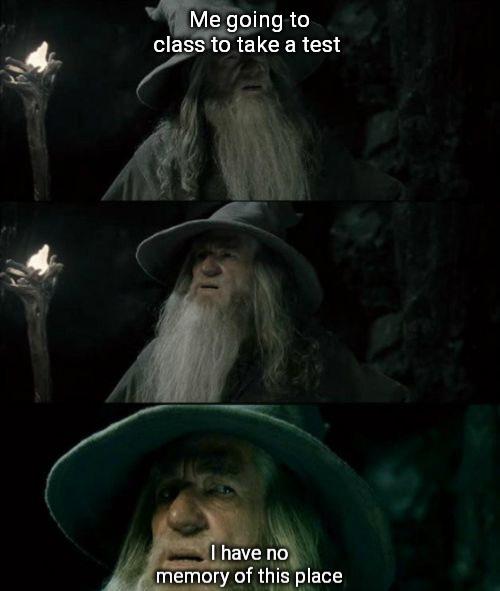
SPOTTED: The Observer's Board of Directors on a midnight adventure around Wade Lagoon
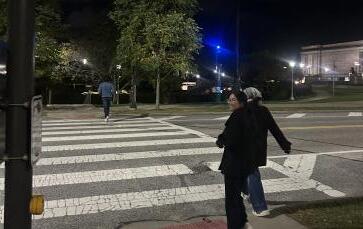
The UMB air conditioning unit broke and now leaks questinoably smelling water down on unsuspecting victims whenever turned on, causing the office to reach peak napping temperatures. We, working into the wee hours of morning on this lovely publication, almost fell victim to these napping conditions. Thus, we ventured into the dead of night to run a lap around Wade Lagoon to rejuvinate ourselves so we could continue our work. Unfortunately we, as one could hypothesize by our being The Observer's Board of Directors, were not properly trained for such a display of athleticism. We are thus pictured walking a mere 1 block into our run. Except for Lucas, who attempted to run away from production night. Auden Koetters/The Observer
And now, a limerick
The Observer has this place left to be seen as white space I must admit One more article and I'll quit And I really don't want it to all go to waste.
Midterm’s Lust
Aphrodite
Greek Goddess of Love
Midterm season is upon us, and tension is in the air. Academic tension. Existential session. Sexual tension. It’s like a triple espresso shot of panic, procrastination and pheromones. You can practically smell the cortisol mixing with Celsius and axe body spray in the KSL air. You’re tired, stressed, half-feral and suddenly that person across the library looks like a Greek god just because they can draw a Fischer projection. You haven’t slept in 3 days, but you have developed a crush on whoever sits near the outlet in the library. Coincidence? No.
You’re not in love. That pulse you feel? It’s not attraction, it’s your body’s fight-or-flight response to you overdosing on stimulants. Those butterflies you feel? It’s the Celsius burning a hole through your stomach lining. But try telling that to your brain when you make accidental eye contact across the sea of whiteboards and your “heart” goes “you know what would be a good way to relieve this stress right now?” Suddenly, every group session feels like foreplay. You’ve convinced yourself this is cosmic chemistry, but it’s actually just mutual academic decay. The library becomes a jungle of repressed desire and fleeting sanity. People whisper equations like sweet nothings. The printers moan. Somewhere, a couple gets it on in the single stall bathroom. Meanwhile, you’re wondering if your unwashed hoodie and dark eye bags make you look mysterious or medically concerning. By fall break, the line between academic collaboration and deeply concerning decisions has fully dissolved. You’re playing emotional chicken with the person in your chem lab, and you’re not sure if you want to kiss them or compare reaction mechanisms. But beware, the moment exams end, so does the delusion. The same person who made your heart race under the flickering fluorescent lights will become just another sleep-deprived engineer who talks about the “moral ramifications of BLAH BLAH BLAH.”
So, if you’re feeling hot, bothered and academically doomed, take a breath. You don’t need romance, you need electrolytes. You don’t need a hookup, you need a nap. Because when it comes to midterm lust, the only thing you should be getting on your knees for is that curve, the only thing you should be scoring is above the mean and the only thing you should be pulling allnighters for is your GPA. And, if all else fails, just remember: love is temporary, but a D in organic chemistry is forever.












It’s not liberation if everyone liberated is dead: America’s intervention in Venezuela risks
no
freedom, only a bloody change in management
Mariana Parilli-Castillo Copy Editor
It is 2025, and I really should not be shocked that I need to remind people that war is bad for an invaded country. Seeing as there are sectors of the American population that assume Palestine and Ukraine are not being devastated by their respective invaders, it’s not hard to assume that the more warmongering segments of the U.S. government (that is, all of them) would be eager to extend its nation’s “freedom” to yet another unsuspecting nation. What does surprise me, though, is the absurdist cruelty through which the government keeps seeking casus belli (a justification for outright war) and the utter insanity of those who want to be bombed sooner and harder all in the name of American democracy. At the same time, as a born and raised Venezuelan, I probably should have gotten accustomed to this level of ontological lunacy years ago.
On Sept. 2, President Donald Trump ordered a strike on a boat supposedly manned by 11 “Tren de Aragua Narco Terrorists” (per Trump’s Truth Social post). Their crime? Sailing on international borders with the alleged intention to traffic drugs into the U.S. Even foregoing the notion that killing non-aggressive civilians for a crime that does not carry either life sentence nor the death penalty under U.S. federal code is wrong, there is no proof that the boat, or any of the other Venezuelan boats that were struck down by the U.S. air force afterwards, were carrying “Tren de Aragua Narco Terrorists.” Indeed, per an investigation by Julie Turkewitz in The New York Times, there is a strong possibility that at least one of the men in that boat was a “fisherman with four children who left one day for work and never came back.” And yet, these unknown men, whose innocence is both likely and disregarded, are slandered endlessly beyond their graves by Trump administrative officials, making them the punchlines of their dehumanizing cruelty.
In an X post Vice President JD
Vance made on Sept. 6, he stated that “killing cartel members who poison our fellow citizens is the highest and best use of our military.” Additionally, he presented this extralegal international aggression and senseless loss of life as a positive action in comparison to that of the Democratic response to the Russian invasion of Ukraine by tweeting “Democrats: let’s send your kids to die in Russia” and “Republicans: actually let’s protect our people from the scum of the earth.” Marco Rubio, former Florida senator and current Secretary of State, is a “pick-me” Latino whose greatest pleasure is throwing his own community under the bus. He has been one of the main pushers of Trump’s foreign policy with Venezuela and has encouraged waging war on what he calls “narcoterrorists,” led by Venezuela’s President Maduro, with the Venezuelan government being positioned as “a terrorist organization and organized crime organization that have taken over a country so that they can become the leaders so that they can become billionaires.”
For all intents and purposes, the U.S. government has positioned Venezuela as a bug to be squashed in the name of American salvation, with any innocent civilian being at risk of being passed off as yet another one of those “narcoterrorists.” And yet, this positioning as the scum of the earth does not phase my countrymen. Instead many just can’t wait to get a taste of the M4 carbine and Blackhawk helicopter brand of American freedom.
As a rule of thumb, the great majority of Venezuelan immigrants believe, like I do, that Nicolas Maduro is a horrible president that has fostered a cruel, corrupt government with keen incompetency and thoughtlessness. Most would actually argue that I am a bit too lenient for not believing he is the Antichrist incarnate. Many of these exíles regard President Trump’s actions as a Holy Grail, an avenue by which Maduro can be overthrown in the bloodiest and most gratifying way, restoring the golden Venezuela from the 80s in a sort of military-enforced time-travel.
It does not matter by what methods or means, it does not matter whether we sell the very land under the feet of Venezuelans who have stayed to a new set of masters; they are ready to risk anything to “liberate” the nation. They see this liberation at the hands of the U.S. government as a manmade Rapture, where those who are righteous and true patriots will survive to see the new-Old Venezuela. What these Venezuelan expatriates forget to account for is that American liberation has a track record for being self-serving, disastrous and bloody. In Latin America alone, the United States has been responsible for some of the most inhumane regimes the continent has ever seen. A famous example of American interventionism is the forceful deposition and assassination of President Salvador Allende and the subsequent imposition of General Augusto Pinochet as President of Chile in 1973 until 1990 (which led to the death, torture or disappearance of more than 40,000 Chileans). Another is the coup d’etat against President João Goulart in 1964 by the CIA-backed Brazilian military junta whose count of 20,000 victims of torture, disappearance and political assassination is now seen as severely undercount-
ed as it is hard to amount in the 21 years it kept control.
Whenever the United States gets involved in Latin America, death and repression follows, but outright war hasn’t been waged since the Banana Wars. The Trump government is not talking about implementing a puppet state, nor is it proposing that Maduro is an illegitimate president and attempting to put in their own candidate as they did in 2020. Instead, they are actively dehumanizing Venezuelans and committing bloodshed before Venezuela has even shot its first bullet. I want to live to see the day Venezuela is free, but I also want to see Venezuela alive. And it shouldn’t be too much to ask for my countrymen to stop courting the devil, as all he will do is rob us from all that made Venezuela the country we love. Yet, I have the feeling that many of the pro-Trump Venezuelan immigrants—who argue that they are “one of the good ones” and who can count on the president to spit in their face and call them rapists and murderers—would prefer to see endless carnage on Venezuelan soil and violent repression to take over every single aspect of Venezuelan society as long as it is no longer under the name of Maduro.

All fingers point to the system, not the person
Isabel Haytayan Contributing Writer
Why did Tyler Robinson do it?
It’s an understandable question, the answer to which all major news outlets reporting on Charlie Kirk’s assassination were searching for in the days after his death. Of course, in any murder case, the issue on everyone’s mind is always the motive. What fervent rationale drove someone to commit such a deliberate and permanent act of hatred against another human being?
The thing is, we never got a clear answer. Sure, we got play-by-plays, diagrams, details about the crime and about Robinson’s personal life. However, all these facts painted an incohesive picture. Though they were heavily speculated on, no one seemed to know
his true political beliefs. He wasn’t registered to any political party and had never voted in an election. The alleged messages he carved on the bullets, though on the surface seemed political, were actually obscure references to video games that “were mostly a big meme.” Robinson was undeniably angry with Kirk’s hateful views and, by nature of his target, this was a political act. However, it didn’t seem like politics had ever been a defining part of his life. So, how did this young man go from aspiring electrician to political assassin?
The United States has a rich and prevalent history of political violence. Dating back to the founding of our country, Americans revolted with pitchforks and rifles, not neat-andtidy documents and bureaucracy. And our history of political assasination runs deep as well. Times of polariza-
tion, close elections and divided populace often bring out the worst urges within troubled individuals. A political assassin’s goals are those of a killer, but they often have the framework of an activist for a twisted cause. These kinds of ideas can also be the reason for political violence on a larger scale; they are what movements are formed around, for better or for worse. In the time after the American Civil War, thousands of black men and women were lynched due to proslavery sentiment in the South. On the other end of the spectrum, after Martin Luther King Jr.’s assassination in 1968, violent uprisings erupted in more than 125 cities. Shared visions for the future—as well as what is seen as a rejection of those visions—by a community of people can often be the cause of this turn to violence.
Political assassins take ideas held
by communities such as political parties or radical groups and turn them into a single moment of concentrated violence. When you think of examples of these assassins throughout our history, you think of men like John Wilkes Booth, an anti-abolitionist who had hated Lincoln his entire life and had been plotting to either kidnap or kill him for much of the Civil War. You think of ambitious men with undeniably political motivations, who want to enact change, to lay the foundation for their vision of America’s future. What you don’t think of, are men devoid of a grand purpose. This is something that Robinson has in common with another attempted assassin from last year: Thomas Crooks.
Continue reading on page 11
A US Army helicopter takes off during a training exercise in Panama. Courtesy of National Archives via GetArchive
All fingers point to the system from page 10
Knowledge of Crooks’ attempt on Donald Trump’s life was widespread, but unlike with Robinson, who was apprehended, his mystery ended with a bullet to the head. And the world, too wrapped up discussing Trump’s response to the attempted assassination to be curious about a dead man’s motives, largely forgot him.
Crooks, like Robinson, didn’t seem to have a grand, political motivation or ideology. His search history reveals that he was looking for an opportunity to commit an attack that would garner the public’s focus, whether through the number of casualties or the killing of a public figure. Trump’s rally just happened to fit the bill.
Rather than assigning to these men activism-centered political motivations, it seems the more accurate comparison would be to another phenomenon of today’s America: the school shooter.
The hallmarks of the school shooter often include loneliness and social isolation or rejection. Like with Robinson, this isolation can cause a turn towards the internet in order to find other avenues of support. As for motivation, shooters often want revenge on their peers for bullying or social rejection. However, some individuals, like Crooks, have no coherent ideology or motivation for their actions, lashing out in search of notoriety. Under-
standing a shooter’s actions is about understanding an ideology of last resort; the vicious cry for attention of an individual consumed by an inner void. Likewise, analyzing Robinson and Crooks’ acts through this lens reveals a more cohesive narrative.
As exemplified by these men, today’s assassins have negligible connections to the kinds of networks that drove the actions of people and movements in America’s past. Instead of political parties or radical groups, they have Discord channels and video games, where they learn rhetoric divorced from coherent ideology—a jumbled, nihilistic attempt to explain an incomprehensible world.
Even so, this doesn’t negate the political consequences of their actions. None of this is stopping the Trump administration from pushing for an attack against liberal institutions in Kirk’s name. There is no doubt the obscurity around Robinson’s motivations will continue to be used as a tool to justify these crackdowns.
Still, defining these men’s actions through a partisan lens will only be to society’s detriment. When we try to see our politics neatly staring back at us in these acts, we fail to realize that the act itself is often the message. So long as the focus remains on placing blame, the despondency that feeds this cycle of violence will only continue to taint American life.
The performative plague
Keona Koh Contributing Writer
The performative male is a lighthearted stereotype and the biggest inside joke in the country right now. Sales of tote bags and wired headphones have never been higher as performative male contests pop up virtually everywhere. Now, when a friend shows up holding a matcha drink in their hand, we can’t help but poke fun at them for their “performativeness.”
But, really, this isn’t a new concept at all. Originally, the components of a performative male were a blueprint for what women appreciated. Carrying tote bags and reading books nonchalantly in cafes created an image of men that was feminising and, subsequently, more trustworthy. It was a fresh breakaway from the alpha male stereotype, something we all needed a breather from.
Once men caught on to the positive response, though, the meaning shifted—they started taking on the outward traits of this new model of a man without absorbing any of the internal character development. The result? Another manifestation of toxic masculinity. Now, men are scrambling to follow the new rubric of how they are expected to look and act without understanding why these expectations came about in the first place, defeating the entire purpose of it all.
But, before you look around you and start laughing at the next guy you catch listening to Clairo and staring idly at a Dostoevsky book, it’s important to realise that we are no better ourselves. Being performative has been around for as long as human emotion has and it isn’t necessarily a bad thing.
In every interaction, we present some altered version of ourselves, sometimes more authentically than others. Whether we like it or not, we care how we’re perceived, and the social choices we make are led by what we think will get others to like us. Maybe it’s the way we dress, the merchandise we attach to our bags or the trending buzzwords we incorporate
The Case Western Reserve Observer
Established in 1969 by the undergraduate students of Case Western Reserve University
Darcy Chew Executive Editor & Publisher
Hannah Johnson Director of Print
Sabrina Feldberg News Editor
Alyssa Wang News Editor
Penelope Cloonan Life Editor
Aleksandra Majewski Opinion Editor
Ellie Palaian Sports Editor
Michelle Bai Copy Editor
Riya Kulkarni Copy Editor
Siya Motwani Copy Editor
We’ve all been there, trying to study or finish that last assignment when all we want to do is … anything else. Maybe we’re overwhelmed with the work we have to do, or maybe we feel the pressures of perfectionism and don’t want to start. We push ourselves to “lock in,” but call it quits too often, feeling guilty each time we pick up our phones to doomscroll again and again. Doing anything but the work we have piled up always seems to feel better than actually getting things done, but the sinking feeling in our stomach knowing we’ve wasted time is much worse. Can we really consider these pauses to be “breaks” if we feel worse after taking them?
Abhishek Nambiar Copy Editor
Mariana Parilli-Castillo Copy Editor
Lily Zhang Copy Editor
DESIGN
Anjali Bhuthpur Director of Design
Lucas Yang Director of Design
Shareen Chahal Layout Designer
Sahar Kapasi Layout Designer
Reva Kolhe Layout Designer
Elizabeth McHugh Layout Designer
Kiera Ng Layout Designer
Nithya Pandari Layout Designer
Jana Ashour Graphic Designer
Kristina Guo Graphic Designer
Sophie Shimeall Graphic Designer
Anna Trusova Graphic Designer
into our everyday conversations. We do things for approval so often that the line between what’s authentic and not becomes blurred.
Wanting approval isn’t the problem. It’s when we purposefully and mindlessly start following the crowd that things start to take a bad turn. Like the performative males, we easily adopt new trends and discard old interests in order to fit in because sometimes what we like doesn’t coincide with what we think we should like. Albeit it isn’t always so daunting as creating iterations of toxic masculinity. I know I’ve definitely found myself hiding when I play my favourite games around the wrong crowd or picking a certain playlist to listen to when I’m with certain people.
But what happens when something that used to be considered cringe suddenly becomes mainstream?
At first, it would seem that having your interests become “cool” is the dream. One day, you’re a loser, the next, everyone thinks you’re trendy. Yet, for some, seeing others now earn praise for announcing their love for something like Hamilton when they once were bullied over it can feel like betrayal, a knife to the heart. Even more disappointing is when, say, a once socially taboo musical artist you like becomes popular, but when you bring it up to someone else, you’re met with “oh, I only know that one TikTok song.” If the subject was “Hamilton,” I wouldn’t be surprised if the original disdainful attitude returned upon hearing mention of any other musical. Saying that you like something simply because it’s mainstream can be misleading for people who truly enjoy said thing, and it’s doing real damage to all of us. Rather than bringing people together, being performative pushes people further apart and creates a social barrier between those who simply like what’s trending and those looking for true enthusiasts to share their passions with. It worsens the already blurry distinction between an authentic personality and an artificial one.
The worst outcome of this wave of performativity is the idea of being
We may trap ourselves in a cycle of counterproductivity and double the time it takes to complete a task. In this “popcorn brain” mindset, we work and get little done, then stop working and think about how we could be working. By the time we resume our work, we feel ashamed, not refreshed, and we stay up late in attempts to catch up.
DIGITAL MEDIA
Auden Koetters Director of Digital Media
Moses Fleischman Web Editor
Ayan Sheikh Video Editor
Matthew Stall Video Editor
Obafami Tidjani Web Editor
Phillip Kornberg Photo Editor
A break is not shameful, not when it has the potential to act as a tool that makes productivity much more efficient. We just need to know how to use them.
Tyler Sun Photo Editor
Esha Bagora Social Media Editor
Benjamin Kang Social Media Editor
Timothy Le Social Media Editor
Just as an athlete wouldn’t do 150 consecutive bicep curls while strength training at the gym, as students we must take meaningful breaks in reasonable intervals. One popular example of this is the Pomodoro method, where 5 minute breaks follow 25 minutes of work (10 minutes of break to 50 minutes of work is also a popular option). By time-boxing our productivity and knowing we will be rewarded, we remain more focused when we
Rhea Soni Social Media Editor
Ethan Daley Sports Broadcaster
BUSINESS
Tyler Vu Director of Business Operations
Riya Dixit Ad Manager
Divya Kurma Business Manager
Anya Lin Analytics Manager
Ria Trivedi Marketing & Distribution Manager
The Observer is the weekly undergraduate student newspaper of Case Western Reserve University. Established in 1969, The Observer reports news affecting students and provides an editorial forum for the university community. Unsigned editorials are typically written by the opinion editor but reflect the majority opinion of the senior editorial staff. Opinion columns are the views of their writers and not necessarily of The Observer staff. For advertising information, contact via e-mail at observer@case.edu. LETTERS TO THE EDITOR should be e-mailed to observer@case.edu or submitted on our website at observer.case.edu. Letters can be mailed to Thwing Center 11111 Euclid Avenue, Suite 01, Cleveland, Ohio 44106. For policy and guidelines related to the submission of Letters to the Editor, refer to observer.case.edu/submit-a-letter.
The Observer is a proud member of CWRU’s University Media Board. Follow The Observer on Facebook, Twitter, TikTok and Instagram @cwruobserver.
“nonchalant.” It’s the ultimate form of cool in current times, and everyone is doing all sorts of things to be labelled as such. But is it really cool to not care? Sure, it referred to effortlessness in the beginning, but now, all I see is people pretending that nothing matters and nothing affects them. To me, it’s stripping us of something so vital to being human: passion. And frankly, it’s sad. We’re so starved for social acceptance that we’re willing to give up any ounce of enthusiasm for, well, life. Even if our lives are a constant social performance, there has to be some room for our true selves. Being performative to
fill that space does us no good.
Performativity is killing our creativity and replacing it with a competition for who follows trends best, even if that means liking nothing at all. We may get a good laugh out of performative male contests, but we’re currently living in a performative contest of our own. That’s not to say we are stuck in it, though. No one is forcing us to conform. It certainly isn’t easy, but I believe that we’ll all truly be happier and more at ease if we embrace authenticity. If there’s one thing we should give up, it isn’t our interests. It’s performativity.
Are curiosity and credential-seeking at odds with each other?
Stephen Li Contributing Writer
Nowadays, much of the content in undergraduate university courses can be found in the public domain. There is nothing revolutionary anymore about the fundamental laws of chemistry and physics, the basic theorems of calculus and the Western philosophical canon. If the only goal of a college education is to transfer information from one individual to another, then the immense amount of work done by educational systems to proliferate knowledge among undergrads and to maintain their functionality is largely unnecessary. In 2025, the global Massive Open Online Courses market surpassed $25 billion, with platforms like Coursera, edX and Khan Academy reaching hundreds of millions of learners.
Yet, contrary to what the starkest interpretation of a university’s purpose would suggest, millions of peo-
which colleges also play through tactics like artificially reducing acceptance rates to increase rankings. Institutions, becoming more “business-like,” spend between $429 and $623 per student each year and in 2019 spent $2.2 billion collectively on advertisements alone, which often emphasize the luxury experience and the brand name of universities. Even if universities remain intellectual crucibles, it is in spite of contemporary developments rather than because of them.
Academic standards provide a common denominator against which individuals can be compared. Undeniably, assessments are necessary incentives in a functioning educational system. But on a more individual level, they often disadvantage students who truly care about a subject. When hundreds of people learn the same material simultaneously, distinguishing between exceptional students and those who are exceptionally good at “gaming the system” is nearly im-
as well-intentioned as they may be, the advice is not much more than a band-aid solution. Curiosity and credentials must compromise with each other, but they are bound to be in perpetual conflict in some capacity as long as education remains a path to wealth and power. Perhaps an effective academic ecosystem is one that negotiates a successful tradeoff between the two. Few, if any, educated individuals would find a problem in someone holding their passion for learning as an important part of their identity. But it is not enough to merely believe in passion and intellectual vitality. One must express these ideals through one’s actions, and, in doing so, it is implied that some sacrifice must be made. Historically established institutions, even if they possess their own flaws, offer a claim to legitimacy that is difficult to procure through other means. A university education sends a universally understood signal about someone’s perceived competence, eliminating
exclusive colleges. Scores, however, cannot objectively define whether someone meets the criteria for “intellectual mastery” because their significance is relative. Total application volume increased 171% between 2014 and 2023. Consequently, American students are more stressed than ever even though A’s comprise 43% of all university letter grades nationally, an increase of 28 percentage points since 1960 and 12 percentage points since 1988. Many students from elite colleges, supposedly the best in the nation, have been shown to not read assigned texts closely enough to form their own opinions on topics and are instead obsessed with accruing frivolous titles from exclusive clubs. They are also reading substantially fewer long-form works, which are often necessary for deep engagement in a subject, because of their past focus on meeting measurable standards valued highly in admissions criteria today. Grade inflation—as it is called—is caused primarily by stu-
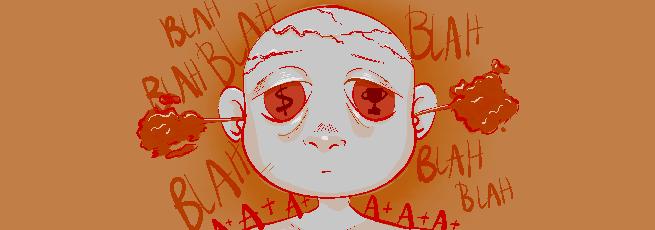
ple pay exorbitant sums of money to access information they can find for free on the internet. Apart from the fact that undergraduate degrees are important pathways to further education, employers still evaluate their droves of applicants through pieces of transcript paper and institution names. The most salient feature of academic institutions is their intricate network of obstacles and procedures which adequately prepare students to surmount similarly enigmatic obstacles and procedures in the workplace. In simpler terms, they are bureaucratic measures.
But many students attend college for a different, perhaps more uplifting reason. A common defense for the value of universities is that they are crucibles of intellectual development. This is supported by the Gallup-Purdue study, which found that professors who inspire students predict a doubling in the probability of engagement at work.
The numbers tell a different story, though. Between 1976 and 2018, while tuition costs have skyrocketed and the humanities have declined precipitously, the number of administrators at American universities rose by 164%, while professional staff ballooned by 452%, far outpacing growth in faculty (92%) and student enrollment (78%).
The pristine landscape of higher education is tainted by prohibitively expensive test prep and consulting companies whose sole purpose is to help clients hack the prestige game,
possible.
A similar problem arises when assignments are graded according to rigid standards in an assembly line fashion, which discourages students from experimenting or making meandering arguments. Academic evaluations are linked with lower autonomous motivation and goals that aim to avoid failure rather than attain positive success. However, goals focused on developing competence, which are linked to desirable outcomes like interest and persistence, are found to be mostly unrelated to academic achievement. University classes can function like bureaucratic machines comprising networks of offices whose purpose is to distribute information evenly among its lowest levels.
Careless errors are not uncommon during exams, nor is remembering a concept only after time is called; individuals with high working memory capacity are especially vulnerable to performance decreases under pressure. Specific grading policies can drastically alter student outcomes even when student input remains unchanged. The academic system in which success is based on standardized metrics incentivizes many students to focus on obtaining acceptable scores using methods like reading barely enough to earn points or even persuading professors into giving undue extensions. Some may advise that “grades do not determine your worth” or preach the virtues of erudition, but
the need for tortuous explanations.
The value of credentials lies in their presentability. But is it possible to uphold one’s ideals if the tasks that one does on a daily basis to achieve imperative goals are dissonant with one’s principles? Intellectual vitality is a nebulous concept which in itself does not prescribe specific actions but is a coveted trait that continually demands proof in forms that can vary significantly based on interpretation. If a critical pillar of one’s identity is supported primarily by an academic system dependent on a small number of decisive and narrowly-designed exams in which results can alter based on random occurrences then it is not difficult to see how academic metrics can lead to negative psychological consequences.
Real world success does not depend solely on ability. A success brought about by the most foolish of fools is still a success, and a grave miscalculation by the most genius of geniuses is still a failure. “Other factors” are present in virtually any undertaking. Reality does not yield itself to any particular individual out of mercy or a sense of fairness. Yet subpar performance on assessments is particularly damning because they were created for the express purpose of gauging ability.
This essential fact of life is apparently unacceptable to the thousands of neurotic, perfectionistic students who earned perfect grades for their entire lives, applying to increasingly
dent pressure on institutions, which has increased alongside the number of college students, in the form of faculty reviews, enrollment numbers and personal appeals. Wellintentioned professors, concerned for the psychological well-being of students under immense social and parental pressure to succeed, inadvertently exacerbated competition by inflating grades. Fixation on credentials leads to a culture where success is expected and failure, an unpleasant but inevitable experience in the real world, is anathema.
This is not necessarily because today’s students inherently lack the virtues necessary for deep thought or that they started with ill intentions, but because of economic incentives that warp what it means to be intellectually competent. So long as credentials define how one’s intellectual abilities are perceived by others, people will never cease to seek more of them in hopes that public approbation, rather than private exploration, is the key to a materially and psychologically stable future.
Perhaps there is some inexplicable urge among talented and ambitious individuals, who succeeded at nearly every endeavor they pursued, to pick up every last scrap they possibly can. Their exceptional aptitude in multiple areas did not necessarily afford them freedom from social or economic pressures. Instead they are chained to their own competence.
Jana Ashour/The Observer
EDITORIAL
Homecoming over homework
Editorial Board
This weekend, Homecoming celebrations and fall festivities abound at Case Western Reserve University, offering opportunities for visiting alumni to commemorate their time spent on campus and for current students to create memories of their own. But there’s an activity that might be even more popular among the CWRU student body—studying.
“I feel like the school’s lack of school spirit isn’t necessarily due to the school, it’s more so due to the people. I feel like people like to keep to themselves here,” Secondyear Eyoha Teshome said.
As students, we are always meeting a deadline or—when we’re not doing homework—taking part in extracurricular activities. Though that contributes to our school spirit, it’s not one that can generally be felt throughout the community. CWRU students often shape their experience to how they see fit without being inspired by CWRU pride itself.
“The biggest thing is community,” second-year Navika Sharma said. “We have got to get more students wearing our school colors and [showing] school pride. We need more activities that bring people together.”
In life, the road to success isn’t a
lonely one. It usually is a collective effort. With community involvement, our own pathways to success will feel more meaningful and rewarding. And though it is up to us students to display our pride, it takes more than that. The arrangement of more community events and spirit-centric rituals can inspire the student body to represent our school. We might get a slice of what it means to have school pride from Homecoming, seeing alums representing our school and community, but this is not nearly enough to sustain us for the entire year.
We’ve all noticed the increase in the new CWRU logo scattered around campus, a branding strategy that has left a lingering taste in the mouths of many. After all, we are all aware that we are at CWRU, so who is this message for? Throwing money at our logo won’t solve our spirit problem—that comes from within. To make better use of administrative funding, incentivizing students to align their actions with the school’s core values, or the organization of more large-scale community-based events would be good places to start.
“We are very low-key when it comes to sports. When there is a low sports turn-out, there’s going to be low school spirit with that as well,” Teshome said.
Making sports games a bigger deal could exponentially influence
the pride we experience as students. Despite current politics threatening the administration with funding cuts, it seems the school has more than enough money to pay for marketing additions to campus that provide nothing to the student body but a big blue eye-sore.
The university is clearly aware of the lack of school spirit on campus as seen by the creation of the CWRU Spirit Committee. In 2024, the committee and University Marketing and Communication birthed Blue CWRU Fridays as an effort to “spur school spirit across campus.”
Special shirt designs were made for purchase, and faculty and staff were incentivized to “dress down” with any CWRU apparel. That the school must provide an incentive to encourage the university community to partake in showing school spirit is telling. If we wish for it to be more than surface-level, the willingness to change should largely and organically come from the student body.
Further, you can’t gain school spirit simply by donning the school colors and wearing the apparel. Spirit runs deeper—it’s holding a sense of pride for the community and campus around us. And it is difficult to cultivate this pride when it seems that decisions made by administration are often isolated from student voices (such as through seemingly random marketing de-
cisions) or at odds with student requests (such as recent changes to meal plans, diversity programs, residential living and expression of free speech).
“I’m sure [the lack of school spirit] has affected those who were really involved in school spirit [in high school],” first-year Althea Amon said. “I think my high school had more school spirit than Case Western does.”
First impressions are crucial. CWRU could put in a greater effort in acclimating its incoming students by facilitating more class interaction. There is an innate agedriven hierarchy at most educational institutions and it should be leveraged to the advantage of guiding first year students toward greater success. If the upperclassmen do it, everyone else follows. So, if the upperclassmen embody the spirit that is the missing puzzle-piece to our school pride, others will do the same.
More and more students may see attendance to school events as lowpriority. It’s easy to feel apathetic towards our community when most students are caught up with deadlines and studying for upcoming exams. This results in a domino effect. It is up to us and the administration to facilitate a shift from a focus on ourselves to our greater community and seeing the bigger picture that we’re all in this together.
The double strandard: At-home genetic testing kits should have stricter ethical guidelines
Afshan Ara Staff Writer
The idea that a single saliva sample can reveal ancestral information, health risks and even personality traits sounds convenient and appealing. Popular companies like 23andMe and AncestryDNA have made their mark on genetic testing for millions of people, and mentions of their name bring about interesting conversations about a person’s identity. Widespread direct-to-consumer genetic testing presents several ethical, scientific and social concerns. When thought about thoroughly, the benefits these companies provide are not worth the consequences.
At-home genetic tests are often marketed as precise and reliable tools that the average person can use to collect a vast amount of information. It is tempting to discover information that could change the way you think about your identity, and companies like 23andMe provide that information without much hassle. Most ancestry tests rely on comparing the collected sample to databases used as references that contain genetic information from various groups of people. However, many of these databases are incomplete and biased towards people of European descent. These databases are not standard and vary from company to company which can create inconsistency. This can be misleading, and people who are from underrepresented populations can receive information that is vague or even contradictory. The results become less credible, and their value in defining identity is diminished.
These limitations can be found
among at-home medical genetic testing as well. More simplified tests only analyze a small fraction of the larger genome, focusing on single nucleotide polymorphisms that are associated with certain diseases. These pieces of genetic code do provide information on certain risk factors, but they cannot account for environmental interactions with genes that affect health outcomes. Somebody may test positive for an allele that is associated with developing Alzheimer’s and panic, only to never develop the disease. Conducting a full clinical evaluation for serious health conditions like Alzheimer’s with a professional specifically trained to advise and assess each person’s risk factors is far more comprehensive and reassuring. At-home tests can introduce unnecessary panic that can be avoided.
Even if the results of these at-home tests are accurate, it can be challenging to leave them to consumers to interpret. The average person may not have the knowledge or skill to identify penetrance and probability of developing a disease. Some people may misunderstand a test result that indicates they have a certain gene and take it as a definitive diagnosis, which only doctors can do. On the other end of the spectrum, a result that implies a “low-risk” for a disease may impart a false sense of security so that people stop seeking standardized health care. Studies have shown that direct-to-consumer genetic testing can lead to heightened mental distress, and discovery of highly personal information can sometimes strain familial relationships as well. Getting this sensitive information about familial relationships and loved ones without proper counseling can induce emotional disturbance that is hard to address on your own.
The most threatening aspect of athome genetic testing kits is data privacy. Genetic data is the most personal and sensitive form of data a person can have and these tests allow people to submit their DNA to large companies that reserve the right to use it for research, marketing and partnership purposes. People may forget that they consent to this when they sign the lengthy agreement forms, and using someone’s genetic information without explicit consent each time raises ethical concerns. An example can be seen in the case where it was used to identify the “Golden State Killer” which was done for social good. Even though this was beneficial, it causes apprehen-
sion because it leads to the possibility of identifying related individuals based on people who did share their DNA with certain databases.
The promise of these tests is alluring and offers a quick and easy solution to questions people may have about their identity and health status. Genetic testing is a powerful and useful tool when it is used properly and privately. Unregulated commercialization of the process allows for feelings of panic, worry and confusion that can be avoided. Our DNA is the key to who we are as humans. It deserves to be protected, respected and held to a high standard of interpretation which is often not provided by at-home testing kits.

Kristina Guo/The Observer
Sports
Guardians’ season ends in Wild Card loss after historic comeback run
Ellie Palaian Sports Editor
After a rollercoaster season, the Cleveland Guardians gave fans a glimpse of hope in the postseason but ultimately fell short on Oct. 2, losing 6-3 to the Detroit Tigers in Game 3 of the American League Wild Card Series (ALCS).
The game remained tight through six innings, with third baseman José Ramírez tying it 1-1 in the fourth before Dillon Dingler’s home run put the Tigers ahead in the sixth. Starting pitcher Slade Cecconi lasted just 2.1 innings, forcing Cleveland’s bullpen to take over early. Pitchers Tim Herrin and Joey Cantillo kept the Guardians within reach, but the momentum shifted in the seventh when
pitcher Hunter Gaddis entered with two runners on and surrendered three straight RBI singles, giving Detroit a commanding 6-1 lead.
Cleveland showed a flash of its signature “Guards Ball” grit in the eighth, when two runs scored on an infield error. But with Ramírez thrown out trying to advance, the rally fizzled, sealing a 6-3 loss, and a heartbreaking end to the Guardians’ remarkable season.
The Guardians’ year was anything but predictable. The team stumbled through the first few months of 2025, enduring a 10-game losing streak before the All-Star break. In July, their struggles deepened as two players were placed on administrative leave amid ongoing MLB investigations, including starting pitcher Luis Ortiz and three-time All-Star closer Em-
manuel Clase. In the month of August, the Guardians had gone just 1-9.
Then came September. In a stunning turnaround, Cleveland mounted one of the greatest comebacks in baseball history, storming back to clinch the AL Central title. They became the first team since 1969 to overcome a 15 1/2 game deficit to win their division, a feat that makes their early playoff exit all the more difficult to swallow.
“The predominant feeling is devastation, because everybody on this team rode the lows and the highs together,” Cecconi told MLB.com. “And the lows and the highs this year were as extreme as you can create. For it to come to a halt this quickly feels terrible. But with those feelings, you don’t want to lose what we did and what we
accomplished from where we were.”
Although their postseason run ended earlier than last year’s ALCS Game 5 appearance, the Guardians delivered an exciting season that kept fans on edge until the very end. While some may be disappointed by the early playoff exit, many take comfort in knowing Cleveland wasn’t even expected to make it this far. The Guardians finished the year on a high note, showcasing their resilience and giving fans plenty of reason for optimism heading into next season.
“We’re close. We are really close,” manager Stephen Vogt said to MLB. com. “We’re not quite there yet. There’s things we need to improve upon. There’s things we need to get better with. But the overarching theme is I’m so proud of that group for not quitting.”

Following a historic comeback throughout September, the Cleveland Guardians’s season came to a heartbreaking end this past Thursday. Courtesy of Wikimedia Commons
Spartans sweep
Daniel
Mullen Memorial Invite with dominant team performances
Ellie Palaian Sports Editor
Over the weekend, the Case Western Reserve University men’s and women’s cross country teams dominated the Daniel Mullen Memorial Invitational, with both squads capturing first place among six competing teams.
The men’s team delivered a commanding performance, placing five runners in the top 10 and 10 in the top 20. Leading the charge were two first-year standouts, Kian Schneeweis and Jay Woodhouse, who finished back-to-back in third and fourth place with times of 28:05.3 and 28:06.9, respectively, out of 87 total competitors.
Three more Spartan runners rounded out the top 10, with graduate student Michael Lombardi placing sixth in 28:13.0, first-year Jacob Porter finishing seventh in
28:19.7, and fourth-year Solomon Greene taking eighth with a time of 28:33.4.
The Spartans sealed the team victory as first-years Tyler Ginther, Caleb Guarino and Devin Montileone finished back-to-back-to-back, claiming 11th, 12th and 13th place, respectively.
The Spartans outpaced Pennsylvania Western University, California; West Virginia Track Club; Wooster College; Allegheny College; host Muskingum University; and Franciscan University to claim the title. Notably, two of the team’s top runners—third-year captain Jacob Slater, who was named UAA Athlete of the Week on Sept. 2 and Sept. 22, and secondyear Donovan Crowley—did not compete in the meet.

Daniel Mullen Memorial Invite from page 14

The women’s team was equally impressive, capturing first place out of six teams with three runners in the top five, five in the top 10, and six in the top 15. First-year Francesca Taracila set the pace for the Spartans, finishing second out of 60 runners in the women’s 6K with a time of 23:24.0. Close behind was fellow first-year Aditi Mukundha, who placed fourth in 23:32.2, followed by second-year Cecilia Postma in fifth at 24:43.3 and first-year Reid Smith in sixth with a time of 24:45.7.
Following the weekend, the Spartan men hold the No. 2 ranking in the Great Lakes Region, while the women sit at No. 5. Among the
standout performances, secondyear Paul Salah posted a seasonbest time in the 8K, while Guarino achieved a career-best mark. On the women’s side, Smith also recorded a personal best in the 6K. Competing in the Daniel Mullen Memorial Invitational for the first time, the Spartans made a strong statement with their dominant showing on the course.
The Spartans will now take a twoweek break before returning to action on Oct. 18 at the Oberlin InterRegional Rumble. After that, they’ll face one of their toughest tests of the season at the UAA Championships on Nov. 1
Spartans close fall tennis season with momentum and high expectations
Ellie Palaian Sports Editor
The Case Western Reserve University men’s and women’s tennis teams concluded their fall seasons this past weekend and will take a break from competition until their official campaigns resume, in November for the men and February for the women.
Throughout September, the men’s team competed in six invitationals, often splitting their 25-player roster into two groups to participate in multiple events simultaneously.
Overall the men have opened the season on a strong note. Fourth-year Matthew Plunkett said the team has made a statement this fall but emphasized that early success doesn’t necessarily translate to results in the spring.
“Sometimes it can be hard to judge the team’s success in the fall,” Plunkett said. “Last year our fall season was generally below our standard, but we brought it around in the spring to have a great season. This year we won more matches than we did last year, and while there is always room to improve, we were able to show the other teams that we are a force to be reckoned with.”
From Sept. 26-29, the Spartans competed in the ITA Fall Regional Championship, finishing with a combined 14-6 record in singles and 6-4 in doubles play. Third-year George Kosseifi, seeded ninth overall, advanced to the semifinals of the singles draw, while second-year Jon Totorica, seeded 17th, reached the quarterfinals. In doubles, the duo of graduate student Bryce Ware and third-year Trey Lambright, also seeded ninth, made it to the semifinals before being eliminated.
“Ultimately we fell just short of
our goal of sending our players to the ITA national championships, but we did have a few big wins, and a few of our guys got quite far,” Plunkett said.
“Heading into the off-season we can feel confident knowing we have a full lineup of guys that can win against the best players in the country, but at the same time we will work harder to get back from losing a couple key matches towards the end of the tournament.”
With a deep roster featuring two graduate students and six fourthyears, the team boasts a strong foundation of experience and leadership. Plunkett views the roster size as an advantage, highlighting the balanced mix of veteran players and newcomers.
“The size of our roster is definitely unique compared to most other tennis teams in the NCAA, but with our team culture being so strong we can make it a positive,” Plunkett said.
“We have a good mix this year of guys returning from last year’s team, and newcomers, with three transfers that can bring their success at other schools to our program. The goal is always to leave the program in a better place than we found it, so while us upperclassmen may be responsible for a lot of the team’s success this year, it is also up to us to lead the younger guys effectively so they can take over our role in a year or two.”
Coming off a standout 2024-25 campaign that ended with a UAA championship and a national runnerup finish to Denison University, the team is eager to carry that momentum into the new season.
“With an NCAA championship and three other finals appearances in the last five years, we are setting the standard that Case Tennis is the best program in the country,” Plunkett


said. “It hurt last year that we were unable to finish the last step in bringing home the championship, but it will not slow us down, and this year will be yet another year where we will be competing for titles, and to end the year in the top spot.”
The women have also started the season strong, competing in three invitationals throughout September. Fourth-year Katalina Wang said she feels encouraged by the team’s early performances and confident in their chemistry and potential as the season progresses.
“I think our team is doing great things so far,” Wang said. “Obviously, we had most of our lineup graduate last year, but I’ve seen the rest of the team step up so much to fill those shoes and grow so much in their game in such a short amount of time. The freshman class is also adapting well to the competitive atmosphere. The vibes are definitely so up.”
The Spartans also competed in the ITA Fall Regional Championship from Sept. 19-21, finishing with an overall 14-9 record, including 8-6 in singles and 6-3 in doubles play.
Wang led the way with an impressive run to the semifinals of the singles draw. She also teamed up with first-year Gabby Lee to reach the quarterfinals in doubles earlier in the weekend. Wang closed out the tournament with a 3-1 singles record and a 2-1 doubles record, improving her season marks to 7-1 in singles and 6-3 in doubles.
“It was amazing to make it this far in the tournament, but it was extremely special to do it in front of the team and our supporters that came out to the site,” Wang said. “In my previous years competing at this tournament, I looked up to some of the older girls on the team and was inspired by their performance. Now being the oldest
on the team this semester, it was surreal to be competing that far in the tournament with the support of the entire team courtside.”
Contrary to the men, the women’s roster is notably young, featuring just two fourth-years and six first-years. Despite the team’s youth, Wang remains optimistic about the season. As the only senior currently on campus, since fellow fourth-year Ellior Rose is studying abroad, Wang has embraced the chance to lead the group while also learning from her younger teammates.
“Our team may not have as much experience, as 5/6 of our starting lineup last year graduated,” Wang said. “However, there is a new excitement that is brought with such a young class and they all show incredible work ethic and a hunger to get better…It has been a great experience being the only senior on such a young team, but they make me a better person and push me to be someone I hope they can look up to.”
To prepare for the upcoming season, the Spartans will continue weekly team lifts and captain-led practices. Second-year Sara Fernandez believes the team has the talent to win the UAA but recognizes that achieving that goal will require relentless effort and energy from everyone.
“I feel like our goal is always to have a competitive season, but obviously looking towards UAAs is the bigger point I think,” Fernandez said. “To do well there we’re all going to have to put our best foot forward on and off the court. I feel like especially in tennis, energy is very contagious, good or bad.”
The men will return to action at the Zach Barden Memorial Invite from Nov. 14-16, while the women will resume play against Hope College on Feb. 6.
The men’s and women’s cross country teams dominated the Daniel Mullen Memorial Invite, with numerous runners on both teams placing within their respective top 20 for the meet.
Courtesy of CWRU Athletics
After a successful fall season, CWRU men’s tennis will be returning in November. Courtesy of CWRU Athletics
After a successful fall season, CWRU women’s tennis will resume in February. Courtesy of CWRU Athletics
Soccer opens UAA play with men’s tie and women’s victory over Rochester Weekly Scores
Men’s Soccer
vs Rochester (10/4) T 1-1
Women’s Soccer
vs Rochester (10/4) W 3-1
Football
at Saint Vincent (10/4) W 42-14
Volleyball
vs Denison (10/4) W 3-1
at Ohio Wesleyan (10/4) W 3-0
Women’s Tennis
Ashland Fall Inviational (10/4-5)
at Ashland No Team Scoring
Cross Country
Daniel Mullen Memorial
Abhishek Nambiar Copy Editor
This past weekend was the first of UAA play for the men’s and women’s soccer teams of Case Western Reserve University. Both teams faced off against their University of Rochester counterparts at DiSanto Field on Saturday, Oct. 4 in a pair of tightly contested matches. Ultimately, the men tied Rochester 1-1, while the women prevailed over the Yellowjackets 3-1.
Commenting on the men’s game, fourth-year forward Stephen Vilardo noted how his team’s tie with Rochester set a strong tone for the rest of the UAA slate.
“I feel like it sets the tone very well,” Vilardo said. “We controlled the ball for the majority of the game and held Rochester to very few chances.”
A similar mentality was echoed by fourth-year midfielder Ceci Dapino in regards to the women’s game.
“Winning the first UAA game is always so important to get the ball rolling,” Dapino said. “The difference in levels between non-conference and UAA can be pretty steep, so a win like this is important for our confidence to know that we can compete with anybody.”
minutes, the first from fourth-year forward/midfielder and co-captain Alexis Sassower and the second from fellow fourth-year midfielder/defender Julia Flynn; both of these shots were blocked by Rochester’s goalkeeper, however. Four subsequent shots over the next ten minutes failed to see the back of the net before the Yellowjackets scored a successful shot in the 16th minute, giving the Spartans their first deficit of the entire season.
Much of the rest of the period was marked by unsuccessful shots from both sides before second-year midfielder Ashley Liang shot into the bottom corner of the goal during the 41st minute, earning her first collegiate goal and leveling the score 1-1.
The second half was all CWRU as the Spartans dominated possession and shots. While the first several minutes of the period would be marked by strong defensive efforts by both sides, the Spartans would break through the tie in the 63rd minute thanks to a shot from Dapino as she slid a goal past the goalkeeper and into the net. This was followed up 12 minutes later by another successful shot by Dapino, solidifying the Spartans’s lead as they continued to hold their ground, and ultimately their victory over the Yellowjackets.
Spartans climbed in the national rankings, moving up from fourth in the nation to third.
Dapino, who was named a Spartan Club Athlete of the Week for Oct. 6 for her efforts during the game, took note of where the team will go from here.
“We know that our next match is going to be tough, but I think after Rochester, the team knows that we’re good enough to get it done,” Dapino said. “Within the team, you can definitely feel the desire to keep winning and proving ourselves against the best teams in the nation.”
Similar sentiments were expressed by Vilardo in regards to the men’s team.
“All of the guys deserve so much credit for the effort and work they have put into our team so far this season, and I think it shows with where we are at this point in the year,” Vilardo said. “However, the work is nowhere near finished and if we are going to have a successful year in the UAA, that needs to continue in everything we do from here until our last game.”
Men’s Team 1st of 7 teams
Women’s Team 1st of 6 teams Invitational (10/4-5)
Upcoming Games
Men’s Soccer vs WashU 10/11
Women’s Soccer
10 a.m., DiSanto Field vs WashU 10/11
12:30p.m., DiSanto Field
First up on the field were the men, with their game kicking off at 11 a.m. The first half showed off the defensive prowess of both sides as neither team was able to score during the period. For CWRU, the period was defined by a series of promising attacks that ultimately came short. Vilardo attempted two shots during the first 20 minutes of the game—his second would be the first shot on goal of the game, though it would be saved by Rochester’s goalkeeper. The same fate would be met by an attempted shot from first-year midfielder Micah Rossen eight minutes later, though Rossen’s shot required a diving save.
The closest the Spartans would come to scoring during the period came in the 41st minute; First-year midfielder Raj Chitre headed a shot that went past the out-of-position goalkeeper, but a Yellowjacket defender was able to deflect the shot and keep the Spartans scoreless going into the second half.
The match presented a new challenge for the Spartans, as it marked the first time all season they had fallen behind and needed to rally to keep their undefeated streak alive. After their performance over the weekend, the
The men’s and women’s teams will both continue the UAA fight this weekend as they host their Washington University in St. Louis counterparts on Saturday, Oct. 11 as part of Homecoming Saturday. The Bears have been tough opponents in the past, as both Spartan squads fell to them last season. The WashU women enter as the reigning NCAA national champions and the WashU men are currently ranked No.7 in the nation.
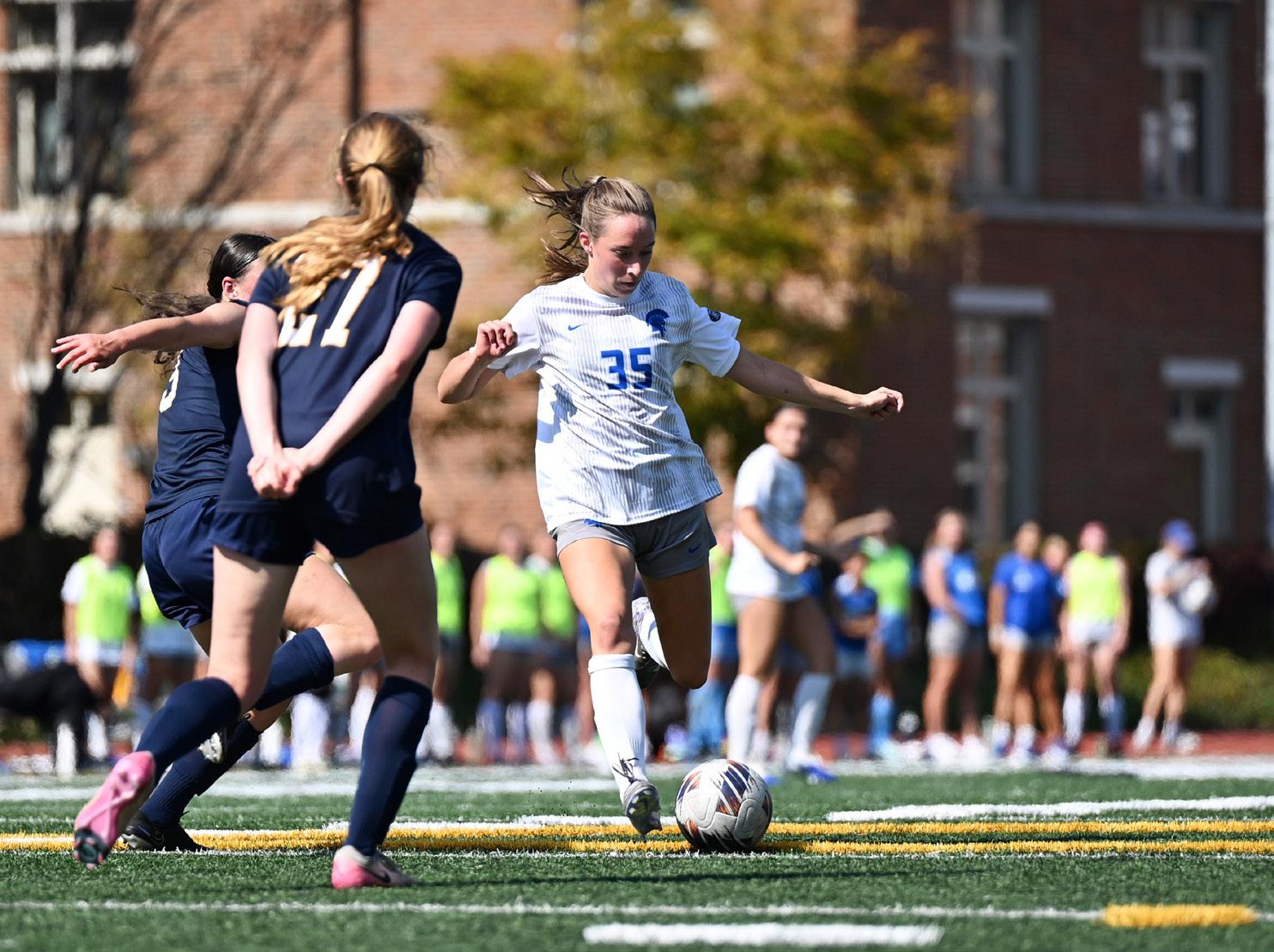
4:30p.m., DiSanto Field
Volleyball Football vs Allegheny 10/11
UAA Round Robin #2 vs Rochester 10/12
noon, Horsburgh Gymnasium vs WashU 10/12
2:00p.m., Horsburgh Gymnasium
at John Carroll 10/15
2:00p.m., Horsburgh Gymnasium
The second half proved to be more fruitful for both teams on the offensive side. In the 67th minute, Rochester broke the scoreless tie when a misplaced pass across CWRU’s backline was intercepted by a Rochester forward near the top of the 18-yard box, leading to the team’s first goal. However, CWRU was quick to respond as Rossen scored in the 70th minute with an assist from second-year midfielder Mitchell Fein. The goal marked Rossen’s second goal of the season and Fein’s first assist of his career.
Hope for a win emerged in the final minutes when fourth-year Ben Collier challenged the Rochester keeper near the top of the 18 and slipped the ball into the back of the net. However, the goal was disallowed as Collier was called for a foul on the play. The final minutes of the match were a further test of the Spartan defense as they successfully fended off a trio of corner kicks by the Yellowjackets.
With the conclusion of the men’s game came the start of the women’s game at 1:30 p.m. This game carried extra stakes for the women’s team as it marked the last chance for fourth-year members of the team to defeat Rochester after having lost to them in 2024 and tying in 2023 and 2022.
CWRU was quick to jump into action with two shots in the first two

The men’s and women’s soccer teams opened UAA play this weekend with a double-header against the University of Rochester. Phillip Kornberg/The Observer
